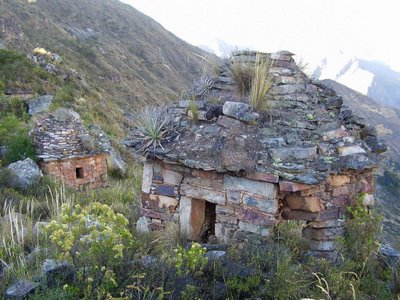The bio-archeaological research is an important part of the project. Marcajirca has many funerary structures, known as chullpas, as well as caves, and semi-caves with human remains. For this reason Marcajirca has enormous potential for physical anthropological studies. This ensemble, (chullpas, caves and semicaves) around 50, most of them, with human bone remains inside. As the site is far from the city, we think it is necessary to implement a strategy which helps us to make quick analyses and optimise results.
Why are tombs dug and bones analysed? The first aim of the research is to know the cult to ancestors; this subject has a deep relationship with funeral patterns. In this case, it is necessary to answer questions such as: were all persons buried in one tomb families or were there other relationships? Were the tombs re-used? Is there a chronological difference between the tombs?
Facing this question, we have designed a strategy which lets us answer these questions. First it would be necessary to determine the minimum number of persons buried in one tomb and we think IT is possible carry out this type of analysis on site. In order to determine if members from one family were buried in one tomb, we need to take bone samples for DNA analyses. To determine if tombs were re-used, first we need to take bone samples for radio carbonic analyses after which the bones are contrasted to determine the bones’ age with DNA analyses. This procedure will help us to determine the chronology of tombs.
The analyses of this funeral structures carried in 2007, have revealed skull with remodelations, reoccupation of this structures, and some bone with osteomelitis, its very interesting the most of bone have in good condition, that mean the individuals were a healthy people, and seem time most of the below to range of sub adult (15-20). At this point, we are trying to determinate whether the caves we built at the same time as the chullpas, we hope our futures excavations will help us with this goal.
Why are tombs dug and bones analysed? The first aim of the research is to know the cult to ancestors; this subject has a deep relationship with funeral patterns. In this case, it is necessary to answer questions such as: were all persons buried in one tomb families or were there other relationships? Were the tombs re-used? Is there a chronological difference between the tombs?
Facing this question, we have designed a strategy which lets us answer these questions. First it would be necessary to determine the minimum number of persons buried in one tomb and we think IT is possible carry out this type of analysis on site. In order to determine if members from one family were buried in one tomb, we need to take bone samples for DNA analyses. To determine if tombs were re-used, first we need to take bone samples for radio carbonic analyses after which the bones are contrasted to determine the bones’ age with DNA analyses. This procedure will help us to determine the chronology of tombs.
The analyses of this funeral structures carried in 2007, have revealed skull with remodelations, reoccupation of this structures, and some bone with osteomelitis, its very interesting the most of bone have in good condition, that mean the individuals were a healthy people, and seem time most of the below to range of sub adult (15-20). At this point, we are trying to determinate whether the caves we built at the same time as the chullpas, we hope our futures excavations will help us with this goal.
At moment we have determinate the presence of 74 individual in a cave, and around 20 in a chullpas. The interesting of this project is that we have to development a strategy between excavation, recover and analyses de bone in the place, all the bones will keep remaining in the cave and chullpas, we think for respect to ancestor they must remain in the original place.
How determinate which bone is older that other a cave is a big problem, due that the archaeological material recover tell us the place was use for long time, in future analyzes, such as DNA and other we will use to determinate the history of bone into the chullpas.
As well we want to know if is possible to difference two ethnics groups, who are identificated by ethno historical documents, but the archaeological evidence is not very clear, so we expecting compared funeral patter from both groups and after comparated DNA from bone both territories.
Our project looks for work archaeologist and physical anthropologist, verification ethno historical information.
The project is focusing on the Late Intermediate Period (1200-1400 AP). During this period there are 2 ethnic groups in the region. We want to compare the DNA of human bones from sites against other sites and the other group ethnic, because this group has been identified through ethno-historical information. Of course, our archaeological evidence will help us to have more information to make these comparisons.
During the season 2008 we dag 3 cave and one chullpas, in addition we are improving a laboratory to make chemical analysis of the bone in order to know the diet of population. We are still proceseing data from this season. The first month the bioarcaheological work was leaded for Stephan Naji from Centre National de la Recherche Scientifique de France CNRS.
For season 2009 we expect to analysis part of bone from last season and dig 02 caves.

In the season 2007 all the physical anthropologist analysis was carried in the site, most of bone stay in the archaeological place; because we think our ancestor have to remain in the place where they use to live. This methodology is only use for us, and we keep it in the next seasons.





.JPG)


Different types of cranial deformation present in Marcajirca
 |
| Poster Present in the IV South-american Paleo-Pathology Association Meeting 2011. Lima. Peru |